The Dell XPS 15 9550 Review: Infinity Edge Lineup Expands
by Brett Howse on March 4, 2016 8:00 AM ESTDisplay
Dell offers two displays on the XPS 15. The base model is a 1920x1080 IPS panel. It’s likely reasonable for most people, but for this review Dell configured out review unit with the upgraded 3840x2160 (UHD) display. This is more than just a resolution bump too. The UHD display also has a backlight which can cover 100% of the Adobe RGB color gamut, or so Dell claims. The standard offering is sRGB only, and the Adobe RGB color space is quite a bit larger, offering more saturation in colors.
However, the majority of the web and most consumer-grade applications are made for the sRGB color space only, so if you use an Adobe RGB display with sRGB as the expected color space, you’ll get an oversaturated image. Display manufacturers combat this by generally offering a way to pick which color space you want to work in. If you are browsing the web, you can choose sRGB, and if you are touching up photos that were captured in Adobe RGB, switch the display to that color space. Dell does this through their PremierColor application on the XPS 15
You can easily switch between the color spaces, as well as several others including DCI-P3 (though I would be somewhat surprised if it could hit it at 100%) and Rec. 709 (which is functionally identical to sRGB), depending on what you are working on. If you open the advanced features, you can tune the color temperature, gamma, and black levels as well. If you don’t have color calibration hardware, this is a quick and dirty way to adjust the display to make it more pleasing.
While we’re in here, Dell also offers another cool feature with this software. They call it the Display Splitter, and its basically an improved version of Windows Snap. You can pick how you want to segment your display, and then when you are dragging windows around, the Display Splitter image will appear. Put the window on the box you want, and the software automatically resizes it and snaps it to the correct location. This is pretty great, and Microsoft should take note of this and work with Dell to get it added to Windows.
Back to the display though, there is sometimes some misconceptions that a display that covers Adobe RGB is going to be more accurate out of the box than one that does not. In fact, it really has no bearing on accuracy at all. What Adobe RGB does is offer a wider gamut of colors, and its up to the laptop manufacturer to ensure that the correct calibration is done to map the correct colors to the display output. To test this, we use SpectraCal’s CalMAN 5 software with a custom workflow. Brightness and contrast are measured with an X-Rite i1Display Pro colorimeter, and color accuracy is tested with an X-Rite i1Pro2 Spectrophotometer.
Brightness and Contrast
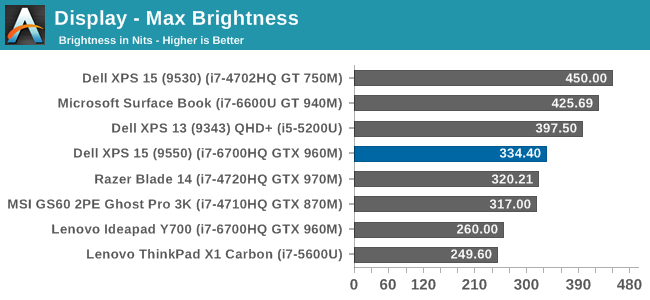
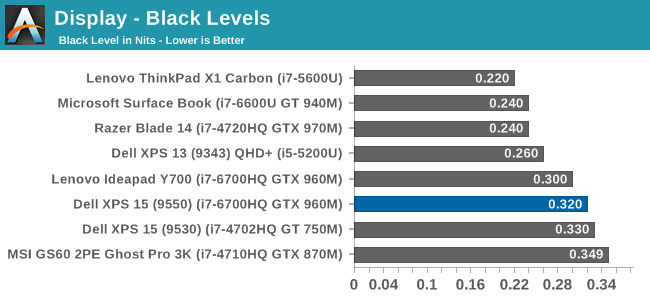
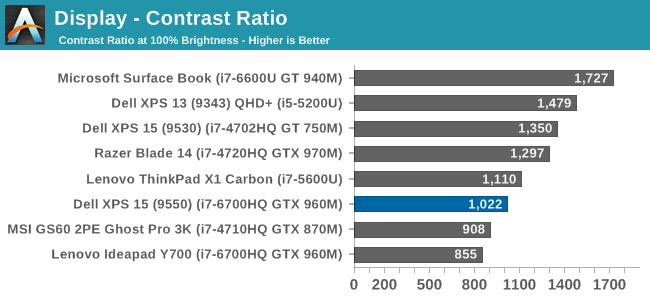
The XPS 15 display can get up to 334 nits, which is plenty bright enough for most tasks, and impressive considering the resolution. Good black levels also lead to a contrast ratio over 1000:1, which is respectable. It’s not class leading anymore, but it’s still a good result. For those that are interested, the display will also go all the way down to 13 nits which should be dim enough for working in the dark.
Grayscale
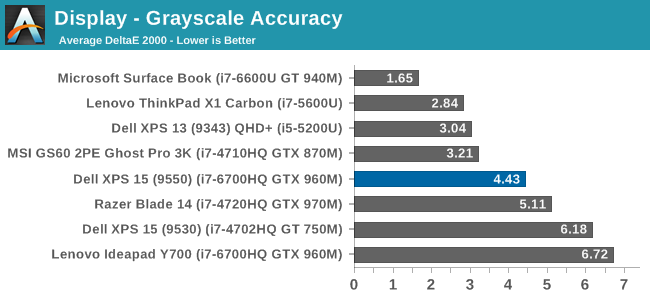
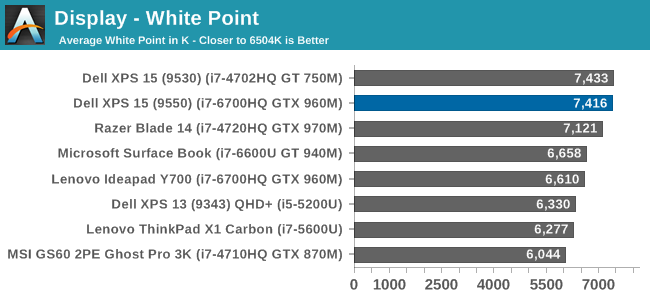
sRGB Grayscale
Adobe RGB Grayscale
Out of the box, the grayscale is not very accurate in either the sRGB or Adobe RGB color spaces. The display has a definite blue cast to it as well, and that plays out in the high color temperature. Gamma is quite good though on both, but Dell should have provided an ICC profile at the minimum to help out with grayscale (or better yet, a calibrated LUT). The UHD display is over a $300 option, so it should be much better calibrated than it is. The color comparator shows how blue the images are.
Saturation
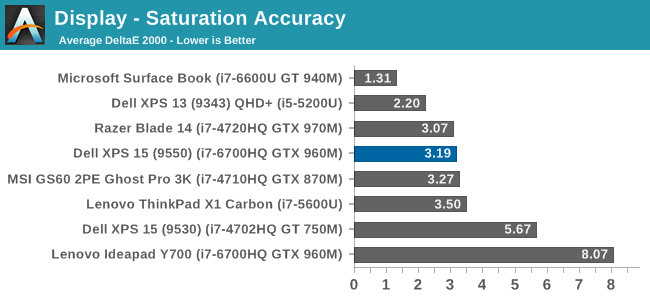
The saturation tests show a better picture than the grayscale though. On both color spaces, the saturation sweeps track nicely all the way to the edges of the gamut. Really only the poor showing on 100% white throws these scores off, with both having an average under 3.0. The images show just how much wider the Adobe RGB space is, and it’s great to see accurate tracking in both modes.
Gretag MacBeth
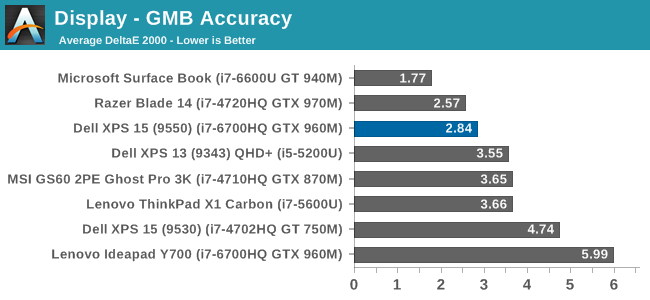
The most comprehensive test is the Gretag MacBeth, which tests an assortment of colors all over the spectrum. It has quite a few flesh tones tested as well. The XPS 15 does ok here too, but is certainly let down by the inaccurate grayscale results.
Calibrated Results
Luckily the biggest issue with the XPS 15 display is grayscale, and that is the one thing that can be adjusted through calibration. I ran the calibration on both the sRGB space and the Adobe RGB space. This had a much bigger impact on the GMB and Saturation scores than normal, since it was the inaccurate grays that were impacting the scores the most.
In sRGB mode, the Delta E for grayscale dropped to 1.6, saturation accuracy was 1.33, and GMB was 1.61, all of which are much better scores than the uncalibrated results. Adobe RGB had an even better grayscale Delta E of 0.9, saturation of 1.0, and GMB of 1.2. Once calibrated, this display is highly accurate. It’s just too bad that Dell didn’t take the time to calibrate it at the factory.
Other than the grayscale issues, the UHD display in the XPS 15 is quite good. It’s great to see more devices starting to offer wider color gamut support, and Dell was good enough to include software to switch the color space as needed.


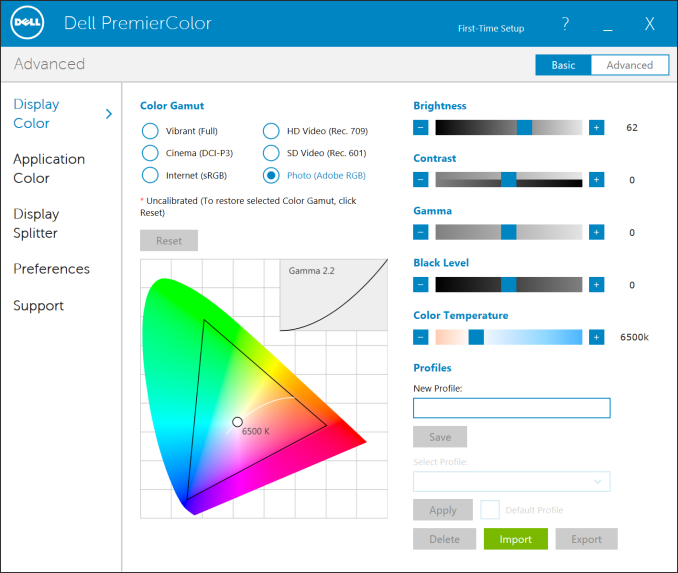

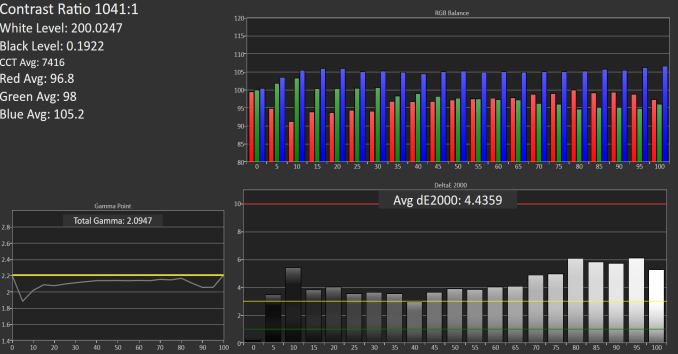

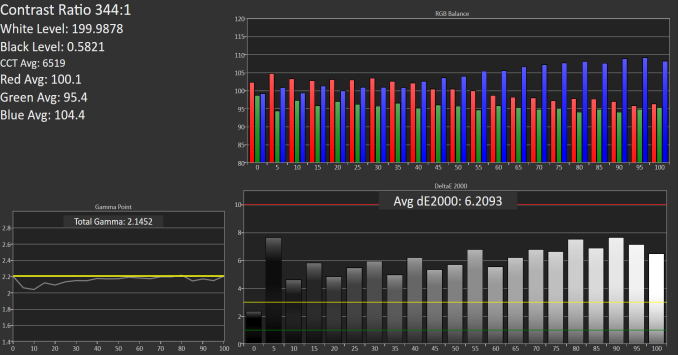


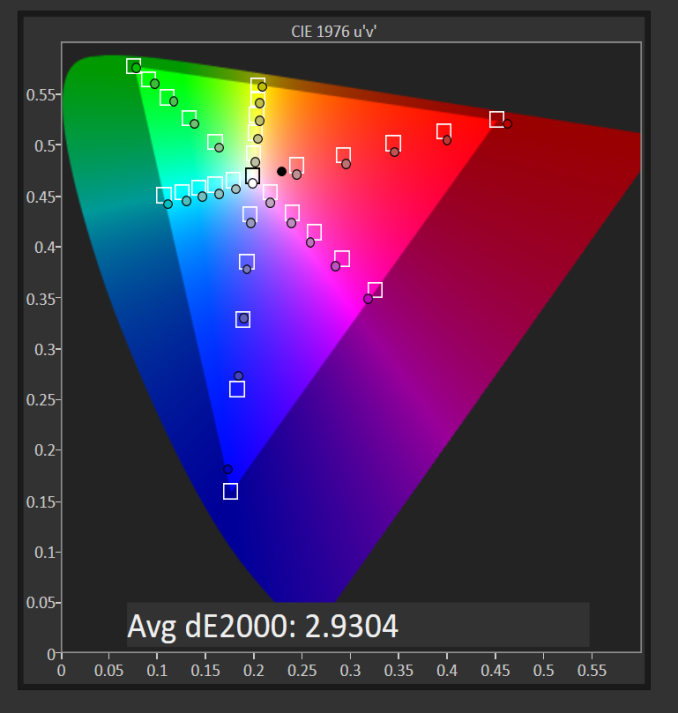
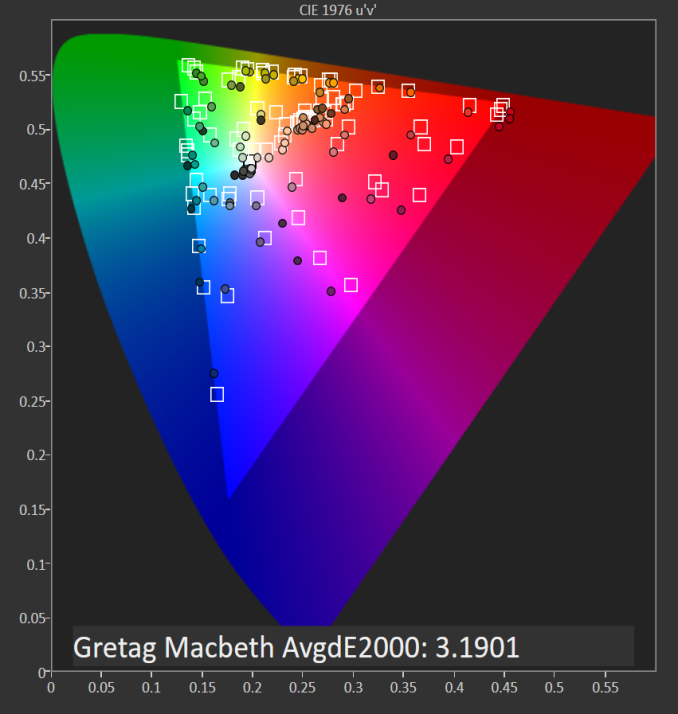

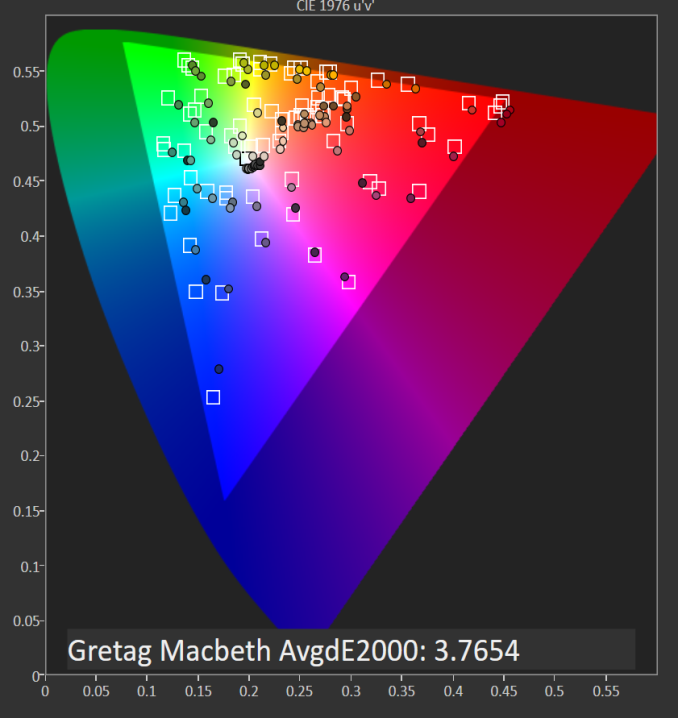















152 Comments
View All Comments
comomolo - Friday, March 4, 2016 - link
I agree with you. It takes little time to make things right. Especially wrong is the picture comparing the size of the XPS 15 to a "regular" 15 incher. They haven't even taken care of a proper shooting point so the comparison is useless.Kristian Vättö - Friday, March 4, 2016 - link
Comparing AnandTech to The Verge is not really fair. The Verge has millions of VC funds behind it, which is why they can have professional photographers and editors taking care of the visual side. They can also have a dedicated office, making it easy to pass devices to photographers and others.AT editors are practically freelancers as everyone works from their home. That means no fancy photo studio with +$10k of gear. Everyone takes their own photos and frankly the quality depends a lot on the equipment one has at hand and how experienced one is. I can speak from experience because I had major struggles with photos during my time at AT. Here's a few examples of the worst and best shots I took:
http://www.anandtech.com/show/7947/micron-m500-dc-...
http://www.anandtech.com/show/7594/samsung-ssd-840...
http://www.anandtech.com/show/9023/the-samsung-ssd...
http://www.anandtech.com/show/8979/samsung-sm951-5...
If you aren't really interested in photography, I can tell you that taking photos is not easy. It's not something you learn overnight. Frankly, taking photos of electronics is even harder because a ton of light is needed, and without proper professional lighting you'll get all sorts of reflections and tints (most house lights are not pure white in my experience, there's a yellow tint to make it "warmer").
All in all, I'm not saying that the photos can't be improve and I'm sure Brett will appreciate any and all tips. I just wanted to explain how AT operates as it's majorly different from The Verge for instance.
nathanddrews - Friday, March 4, 2016 - link
No disrespect to The Verge (and no attempt to brown nose AT), but their reviews are nowhere near the level of AT. It's such a massive divide as to be comical.If we're going to get picky about photography skills and not discuss the actual product, many of those linked Verge photos appear to be out of focus and the lightboxes used aren't exactly top of the line, so between the two reviews, I would say AT wins hands down.
To each his own, then?
pikatung - Friday, March 4, 2016 - link
Probably the best photography I've seen on a tech review site, done on a budget, is from TechReport. They even made a (couple) of blog posts detailing how they do it:http://techreport.com/blog/16645/let-there-be-ligh...
http://techreport.com/blog/22825/how-tr-gets-some-...
(Loyal Reader of AnandTech and TechReport for years)
pikatung - Friday, March 4, 2016 - link
And just to show how good shots can be done on a budget:http://techreport.com/blog/15857/who-needs-a-prope...
And I apologize, I don't mean to be whiny. I really do appreciate the in-depth reviews that you all do. Just hopefully some of these links will be helpful and encouraging.
Brett Howse - Monday, March 7, 2016 - link
Always appreciate tips and feedback. Thanks a lot! I'll check this out.Refuge - Friday, March 4, 2016 - link
I don't come here for the photos, I come here for the raw, cold, hard data.If I want glam shots before I put it in my office, then i'll google around. If I want an in depth, and educational review, I come to Anand.
Solandri - Friday, March 4, 2016 - link
And hopefully that raw, cold, hard data has been transcribed correctly? The photos aren't merely glamour shots. They can give you detailed information about layouts, colors, fonts, etc. A lot of times it's easier to just look at the pictures to see what ports a laptop has, rather than read a list of ports and *hope* they got it right. Other qualities like keyboard layout, trackpad size position relative to keyboard, size of Fn and arrow keys, etc. are much better conveyed via (undistorted) photos rather than a written description.Yeah you can waste time searching for pictures elsewhere. That doesn't mean the site can't be improved by including decent pictures here. (And the problems I see aren't only distortion. Several of the photos are just plain blurry. If you can afford a $800 camera, you can afford a $100 tripod.)
Zap - Friday, March 4, 2016 - link
One possible workaround for objects closer to 2D such as those SSDs are to just put them on a flatbed scanner. No distortion and super clear images.euskalzabe - Friday, March 4, 2016 - link
Here's a couple dead easy tips that improve electronics photography: 1) click the distortion correction checkbox on Photoshop or activate it in-camera. 2) Use bounce flash: if they can't spend lots of money on a decent flash, just use the regular one from camera, take business card, wrap it in tinfoil and place it in front of the flash at 45 degrees. That will bounce the forward light up at 90 degrees, effectively giving you a DIY bounce flash (there's tons of tutorials online).No need for professional photographers or tons of money. Just attention to detail and being a bit handy with DIY techniques. It's really not hard/costly, at all. I still appreciate the great analysis in AT... but I hold them to a higher standard, which shouldn't be regarded as a bad thing. I want them to be better at everything and succeed further in the future.